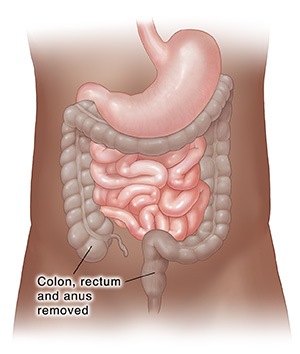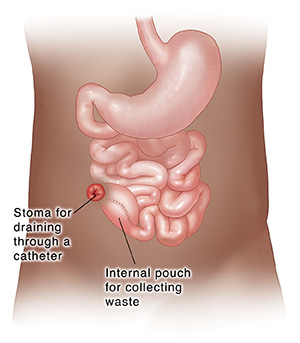Having Bowel Surgery: Continent Ileostomy
This surgery is done to treat diseases of the digestive tract. It removes all of your large intestine. During the surgery, an opening (stoma) is made in your belly (abdomen). When healed, waste collects in a pouch inside your body. It's then drained through a thin tube (catheter) inserted through the stoma. A bandage covers the stoma when it’s not in use.
This surgery may be done with open surgery or laparoscopic surgery:
Your healthcare provider can discuss which option will be best for you.


Getting ready for surgery
Follow any instructions about getting ready from your healthcare provider. You may start getting ready a few weeks before surgery. This can include the following:
-
If you smoke, try to quit. Ask your healthcare team for help. Quitting can help you heal and reduce your risk of complications like wound infections and breathing problems.
-
Tell your provider about any medicines you're taking. You may need to stop taking all or some of these before your surgery. This includes:
-
Prescription medicines
-
Aspirin and over-the-counter pain and fever medicines (NSAIDS or nonsteroidal anti-inflammatory drugs), such as ibuprofen
-
Blood-thinning medicines (anticoagulants)
-
Illegal drugs
-
Herbs, vitamins, minerals, and other supplements
-
If you drink alcohol, let your healthcare provider know how much you drink. This is even more important if you're a heavy drinker. Alcohol withdrawal can be life-threatening. So be honest with your provider.
-
If you'll have a stoma, a specially trained nurse will likely meet with you. This nurse is called an enterostomal therapy (ET) nurse or a wound, ostomy, and continence (WOC) nurse. Together you'll decide on the stoma’s placement. An ileostomy is often placed in the right lower part of the belly. After the surgery, this nurse will see you and answer any questions you have. They'll also teach you (and your family if you wish) about caring for the ostomy.
-
Follow any directions you're given for taking medicine and for not eating or drinking before surgery. This includes any instructions for bowel prep.
The procedure
This surgery is done for people who don’t want to have a pouch outside of their body to collect waste. It may be done after a lifelong (permanent) ileostomy.
Risks and complications
Bowel surgery has certain risks and possible complications. Your healthcare provider can talk about them with you. They may include:
-
Infection
-
Injury to nearby organs
-
A pouch that leaks
-
Blood clots
-
Risks linked to anesthesia
-
Complications at the stoma area such as bleeding, blockage, or a hernia
-
Scar tissue that blocks the bowel (adhesions)
-
Internal bleeding
© 2000-2025 The StayWell Company, LLC. All rights reserved. This information is not intended as a substitute for professional medical care. Always follow your healthcare professional's instructions.